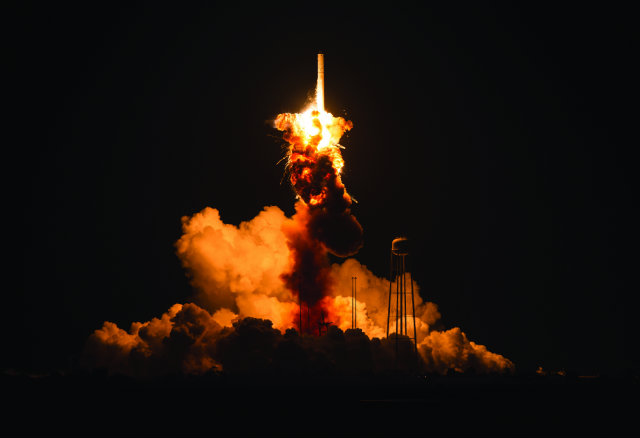At that time, Orbital’s chief executive David Thompson, who now heads the combined company, described a “merger-of-equals” that would bring together “innovative developers and cost-efficient manufacturers who have worked closely together for over 25 years” with “complementary technologies, products and know-how and highly-compatible cultures”.
Indeed, ATK’s focus was solid rocket motors, satellite systems and composite structures, while Orbital’s expertise lay in satellites and small launch systems – including missile interceptors and the three-stage Pegasus air-launched rocket capable of orbiting some 600kg after release from the company’s modified Lockheed L1011 Tristar. Orbital also makes a larger rocket, Antares, developed to push Orbital’s own Cygnus unmanned supply capsule to the International Space Station, as contracted to NASA.
Happier still, at least for those who find discomfort in conglomerates, the deal included a congenial spin-off of ATK’s so-called “sporting” division – which makes one of the USA’s most popular brands of small-arms ammunition.
Moreover, the logic for the merger was, and remains, compelling given the earthquakes rattling the two companies’ domains of business. With US defence spending in a long-running downturn and Elon Musk’s start-up SpaceX lighting a competitive rocket under a launch industry already facing a cost and revenue squeeze, anybody playing in both the defence and space sectors is ill-advised to presume viability in business as usual.
Then, an Antares rocket exploded.
The spectacular 28 October failure – just meters off the ground at Wallops Island, Virginia (pictured) – destroyed the ISS-bound Cygnus capsule and left the launch pad and surrounding infrastructure in a rather bad way. The rocket and spacecraft alone, not including cargo, were worth some $200 million, a cost to be shared by NASA and Orbital.
Such things happen in spaceflight but fortunately no-one was injured and while the incident and financial hit didn’tderail the merger, it did delay its completion by a month, to the end of January 2015.
So while nothing is certain in the launch business until the payload has been delivered, the company now known as Orbital ATK is clearly encouraged by recent events. For the first six months of 2015, revenue edged up 2% to $2.25 billion, but operating profit surged by nearly a third to $248 million, results which Thompson described as sufficiently “excellent” to boost the earnings outlook and underpin an expansion of capital spending plans.
And now, the company has tied up a major supply deal with the big name in the US launch industry, United Launch Alliance (ULA), to develop new solid rocket boosters for its venerable Atlas V launch vehicle and the modular Vulcan that will replace it – and eventually its bigger Delta IV stablemate – from about 2019. That deal puts Orbital ATK alongside Blue Origin, the space company started by Amazon billionaire Jeff Bezos, which is working with ULA to develop its BE-4 engines for Vulcan.
Meanwhile, ULA is helping bridge the gap to Antares’s return-to-flight. Soon after the Wallops explosion, one Atlas V flight was bought to meet Orbital’s ISS resupply contract with NASA, and a second was bought as launch schedule imperatives heated up following the 28 June failure of an ISS-bound SpaceX Falcon 9.

Not as big a disaster as it looks
Rex Features
As Orbital ATK’s vice president for flight systems strategy and business development Mark Pieczynski toldFlightglobal, the company’s status as supplier, customer and competitor to ULA is “normal” in the launch industry. And, he adds, Orbital’s space systems people have 30 years’ experience integrating their own spacecraft with various launchers, so fitting Cygnus to Atlas V was not exceptional.
As for Antares, Pieczynski says refurbishment of the launch facilities at Wallops should be complete later this month, and preparations are under way there for a mission-length vertical static firing in early 2016 of the rocket’s two-engine first stage. Return to flight should follow.
Separately, he adds, Orbital ATK is awaiting a possibly imminent decision from the US Air Force that could see it win funding to work on an all-new launcher. One casualty of the sanctions tit-for-tat over the Ukraine crisis has been theRussia-sourced RD-180 engines used in Atlas V, so the USAF has been exploring ways to replace that engine while assuring access to space for national security launches – defined as having at least two launcher types available – and introducing competitive tendering for those launches.
For a decade now, US national security launch access has been guaranteed by the availability of Delta IV and Atlas V whose makers, Boeing and Lockheed Martin, went on to pool resources and create the joint venture that is ULA. Earlier this year, SpaceX won the right to compete for those launches in future, but its Falcon 9 rocket is only suitable for some missions; the bigger Falcon Heavy has yet to fly, so the USAF could well decide that Orbital ATK’s proposed all-solid-fuel launcher is worth pursuing.
Indeed, times are interesting in the launch business. A US Government Accountability Office report from August 2015 into USAF procurement strategies notes the appeal of competitive contracting, but concludes that “the ability of the federal government and the commercial launch market to sustain two or more launch providers is unknown at this time”.
For its part, Orbital ATK is bullish. As Pieczynski puts it, the market includes national security launches, ISS resupply, NASA civil applications and customers worldwide: “Our business case closes with a handful of launches [yearly].”
Source: FlightGlobal.com
















